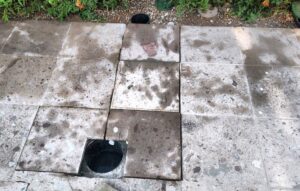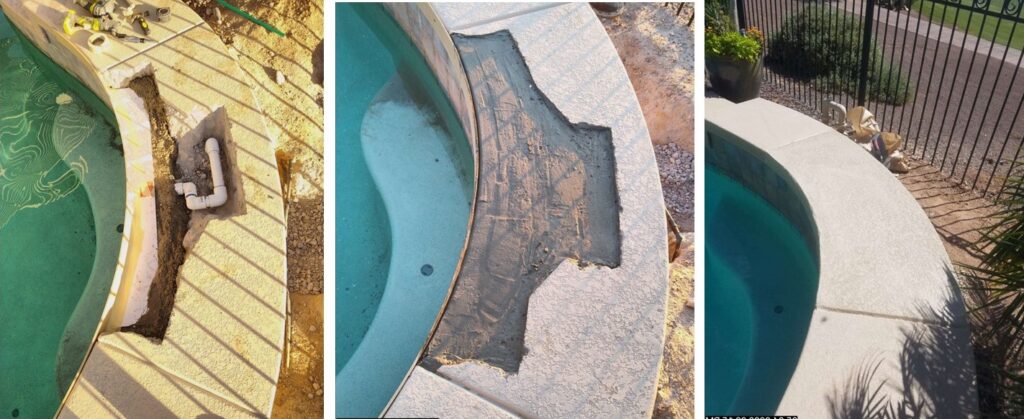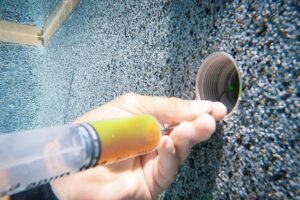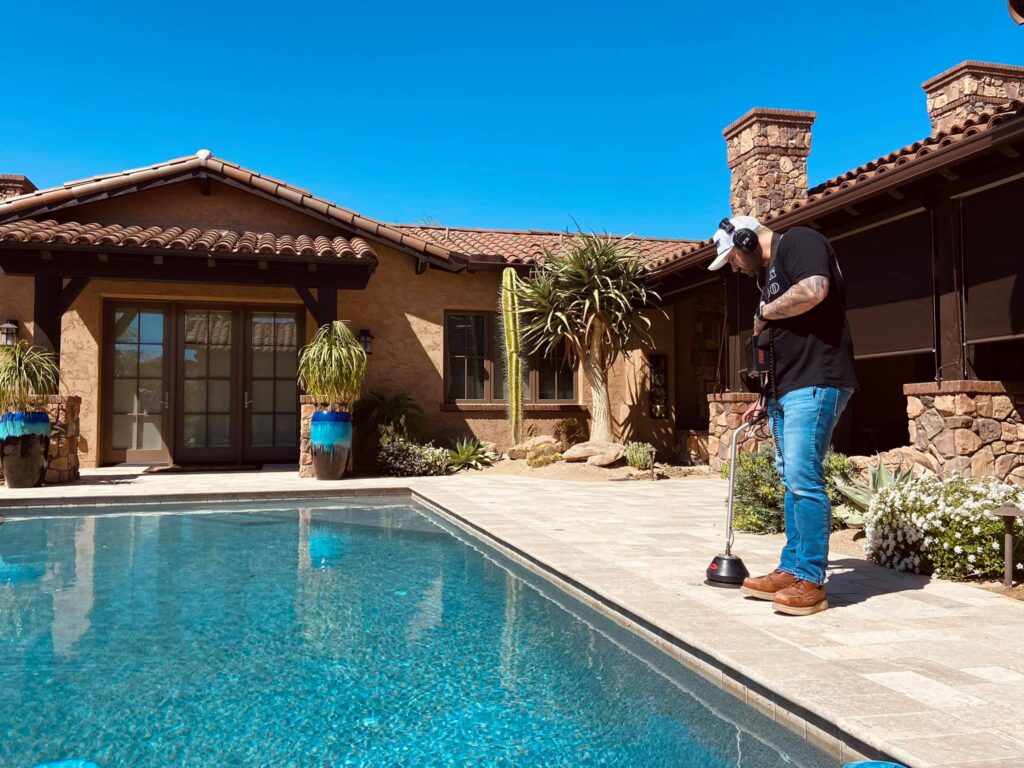Did You Know that an estimated 20% of pools in Arizona have leaks? Water – Use It Wisely, with permission, is reposting this blog from our favorite home advisor, Rosie on the House.
* * *
Thanks to an abundance of winter rains and significant snowpack, we’re seeing less drought news in the headlines . . . for now.
However, that doesn’t mean conserving water isn’t important. If you have a pool, you need to take steps to ensure it is not leaking, and if it is, locate the leak(s) and repair it.
Ian Hanley, owner, Pinpoint Leak Detection & Repair, a Rosie on the House Certified Partner discusses how a pool leak can cause major issues, how to find a leak and then repair it.
Common Areas & Signs of Water Leaks
Water loss is the most obvious sign of a pool leak. But there are other signs to look for:
Higher Water Bills
Higher water bills can happen for many reasons, and one of them is a pool leak. This sign is especially important in pools with an auto-filler because the pool’s water level is automatically adjusted. With water being automatically added, you probably won’t notice the water level dropping, so the excessive water use will only be obvious on your water bill.
Chemical Imbalance

Balancing the pool’s chemicals should be a part of its regular maintenance. Your pool’s water should be tested weekly and adjusted accordingly. When a pool loses water, it takes the chemicals along with it, making it an ideal place for algae to grow. If you are having trouble keeping the pool’s chemical levels balanced or algae is consistently present, a leak is likely the culprit.
Wet Spots
Lingering wet spots in your yard or pool deck are signs of a leaking pool. Just because there are consistent wet spots in a particular spot, doesn’t mean the leak is located there. Water travels. Wet spots could pop up in one area while the actual leak is across the yard. Before you start digging, contact a leak detection professional to pinpoint the exact location of the leak. You could save a yourself a lot of work and landscape damage.
Cracked or Falling Tiles
Tiles can crack because of the movement of the earth’s surface over time. They can also crack because the water level has dropped too low. When the water drops too low, the tiles are exposed to excessive sunlight which dries them out and makes them prone to cracking. Once a crack has formed, water will find its way in and slowly damage the pool’s surface and structure.

Long Term Effects of Undetected Leaks
A leaky pool is wasteful.
Wasted Money
The longer pool leaks go unnoticed, the more damage they cause and the more money you’ll end up spending on repairs down the road.
Wasted Water
While repairs can be done to reverse the damage, the lasting effects on the environment aren’t as easy to remedy. Your pool could leak hundreds of gallons. “Multiply that by the estimated 20% of pools in Arizona that are leaking, and the total amount of water being wasted is unfathomable,” states Ian.
You can test for a pool leak with this DIY Bucket Test.
Property Surveys

“Not sure whether you have a leak in your pool, home, or landscaping?” asks Ian. “We can do a property survey to find out.”
During a property survey, a technician will walk the entire property and isolate each individual area separately to identify which area(s) is leaking. These areas include the home, yard, and pool. Once the survey is done, they will schedule leak detection to find the exact location of the leak within that area.
Specialty Leak Locating Equipment
When a leak can’t be located via the DIY method, it’s time to call a professional. “We use various methods to locate leaks,” says Ian.
Dye Testing
A dye test is used for testing cracks and crevices in the pool’s surface, skimmers, lights, and fittings. Using a syringe, a small amount of dye is pushed towards the suspected areas. If the dye is pulled into that area, there is a leak. If the dye stays and slowly disappears as it mixes with the water, there is not a leak in that location.
Pressure Testing
“Pressure testing allows us to figure out whether or not any of the suspected plumbing lines have a leak present,” says Ian. “We plug off the lines, induce them with Co2 and monitor the pressure gauge connected to the lines. If pressure is held, there is no leak. If pressure drops, then there is a leak, and it will need to be repaired.”
Sonar Technology & Listening Devices
This innovative method is non-invasive and relies on sound to pinpoint the location of a leak. It starts by inducing the underground lines with air and using sonar equipment to listen for leaks. “We know there is a leak when a sort of boiling noise is heard where the air meets the leak. This method helps avoid the need to dig up the yard when searching for the location of a pool leak,” Ian says.

Repair Techniques and Best Practices
Repairing a leak depends on the leak found and the cause of it. “For example, for underground plumbing leaks, we usually dig up the area where the leak is found, and we’ll cut out the part of the plumbing that has a leak and replace it,” says Ian. “Another example is if It’s a leak due to a crack in the pool, depending on the severity, it will either get patched or a complete resurfacing may be necessary. No matter what, we will do our best to make the area that is repaired look the same as it did before.”
The best way to avoid pool leaks is to keep up with regular maintenance and repairs. Keeping chemicals balanced, emptying baskets, vacuuming, brushing, and equipment monitoring, are all a part of regular maintenance. PinPoint Leak Detection & Repair recommends regular equipment inspections to ensure everything is operating properly. If you notice something broken or not working, repair it immediately to avoid further damage to the rest of your pool and its equipment. One issue can create a domino effect of problems and before you know it, that one small repair just became multiple big ones.
Be A Good Neighbor
Leaks don’t have boundaries. The water from your leak can make its way into your neighbor’s yard and wreak havoc. This is another reason why finding the leak before it progresses is important. “You don’t want to find yourself paying for your neighbor’s damages on top of your own,” cautions Ian.
From time to time, Water – Use It Wisely features guest bloggers who write about topics related to water and water conservation. This month, we are featuring Rosie on the House and Pinpoint Leak Detection and Repair. Rosie on the House is Arizona’s longest-running weekend radio broadcast with a loyal following. The show’s content focuses on the needs of homeowners.
Rosie on the House Special Offer
This blog was originally published on May 2, 2023 and can be found here. Upon request, PinPoint Leak Detection & Repair will mail you a free water loss test card (DIY test) that confirms if have a leak before you commit to leak detection. Contact them at 602.777.0771. They are licensed, bonded, insured and have over 20 years in the pool industry.
More details on how to care for your pool or even remove your pool can be found on our Water – Use It Wisely Swimming Pools resources page. And, be sure to visit these other informative blogs about swimming pools:
- How to Drain or Backwash Your Pool
- Using Swimming Pool Water on Plants
- Saving Water in Swimming Pools: 5 Ways to Cut Evaporation
- Saving Water in Swimming Pools: 5 Ways to Cut Pool Water Loss
- How to Reduce Chemical Use in Your Pool


